Frequently Asked Questions
Egg Cookery
What can leftover yolks be used for?
Leftover yolks can be stored in a covered container (cover with a little cold water to prevent drying) in the refrigerator for 2-4 days. These yolks can be used in recipes like hollandaise sauce for Eggs Benedict, or can be used to thicken sauces etc.
Egg yolks can be frozen as well – Beat in either 1/8 tsp salt or 1 1/2 tsp sugar or corn syrup per 1/4 cup of yolk (about 4 yolks). Pour into freezer container and cover with tight-fitting lid. Label with the number of yolks, the date, and whether you added salt (for savoury dishes) or sweetener (for baking or desserts). Substitute 1 tbsp of thawed egg yolks for 1 large fresh yolk. Yolk mixture can also be frozen in ice cube trays (1 tbsp portion sizes). Once frozen, place individual frozen yolks from ice cube tray in freezer bag to avoid drying out.
What is the white ropey strand sometimes visible in an egg?
These strands are called chalazae and are a natural part of the egg. They anchor the yolk in the centre of the egg white and are perfectly safe to eat. The fresher the egg, the more prominent the chalazae will be. The chalazae do not need to be removed unless you are making a smooth custard or sauce. They can be removed with the tip of a knife or strained from a beaten egg mixture.
How can you tell if an egg is raw or hard-cooked without cracking it open?
Place the egg on its side and spin it around with your fingers. A hard-cooked egg will spin smoothly and rapidly. A raw egg will wobble and spin slowly because the liquid centre will prevent the egg from building up momentum to keep it turning.
What causes the grey/green ring that sometimes appears around the yolk of hard-cooked eggs?
This discoloration is the result of a reaction between the sulfur and iron naturally found in eggs. It occurs when eggs are overcooked, or when there is a high level of iron in the cooking water. Although the colour isn’t very attractive, the eggs are safe to eat and will still be nutritious and flavourful. An appropriate cooking time and rapid cooling of the eggs after they are cooked will prevent the formation of this grey or green ring.
Can eggs be safely cooked in the microwave?
Using the microwave is a quick and easy way to cook eggs:
1) Spray a small dish or mug with cooking spray or place 1/2 teaspoon (2 mL) butter or margarine in the dish and heat in the microwave for a few seconds. Rotate the dish so the melted butter coats all sides.
2) Crack an egg into the dish. Pierce the yolk with a fork or toothpick. Cover but leave a place for venting.
3) Microwave on Medium-High (70% power) for 45 seconds to 1 minutes. (Cooking time and power level will vary depending on the power of the microwave.) The egg should be undercooked slightly as it will continue to cook as it stands. Let stand for one minute.
*Note: Eggs should never be microwaved in the shell unless a container specifically designed for this purpose is used. Cooking or reheating eggs in the shell may cause them to burst open, creating a mess and possibly damaging your microwave or injuring you. *For microwave cooking, choose a good quality microwaveable container, round shapes work best for cooking eggs.
What is the dark red spot occasionally found in an egg?
It is a blood spot that is caused by the rupture of a blood vessel in the hen when the egg is forming. This occurrence is rare. Blood spots are usually detected during the candling process at the grading station, where eggs pass over a bright light to make the interior of the egg visible. These eggs are then removed before going to the grocery store. Sometimes due to the density of the shell or shell colour (brown eggs), these spots are difficult to detect. An egg with a blood spot is safe to eat, and you can cook and bake with it in the usual ways. If you wish, you can remove the spot with the tip of a knife before you cook the egg.
Substitutions: If a recipe calls for 1 large egg - can I still use a small egg?
| Extra Large | Medium | Small | |
|---|---|---|---|
| 1 large | 1 | 1 | 1 |
| 2 large | 2 | 2 | 3 |
| 3 large | 3 | 4 | 4 |
| 4 large | 3 | 5 | 6 |
| 5 large | 4 | 6 | 7 |
| 6 large | 5 | 7 | 8 |
…or, if you have extra whites, you can use 1 whole egg + 2 egg whites for every 2 eggs in a recipe.
What temperature is best for cooking eggs?
Use moderate heat when cooking eggs. Cooking eggs at too high a temperature, or for too long at a low temperature, causes toughening of both the egg white and the egg yolk.
Why are eggs packed in the carton with the large end up?
Eggs are packed in cartons with the larger, rounder end up. This helps to keep the yolk in its natural position.
Can I make poached eggs ahead of time?
Poached eggs can be made hours or even a day or two ahead. Under-poach them slightly and store in ice-cold water. Immerse in barely simmering water for one to two minutes.
Do scrambled eggs have to be served immediately?
Although it is best to serve scrambled eggs immediately after cooking, you can hold them for a short time by placing them over a pan of hot water and covering. (Scrambled eggs will become rubbery if held over direct heat.)
How can I get the best looking eggs for poaching or frying?
Use the freshest possible eggs for poaching or frying. Fresh egg yolks are higher, and whites are thick and close to the yolk.
How should I store my eggs?
Refrigerate eggs immediately to maintain freshness. Egg shells are porous and should be kept away from strong smelling foods in the refrigerator. To prevent moisure loss and for additional odour protection, eggs should be stored in their carton. Store leftover yolks or whites in airtight containers and use as quickly as possible. Cover yolks with cold water to prevent drying.
How should I transport perishable foods, like eggs?
When transporting perishable foods such as devilled eggs, be sure to pack them on ice in an insulated cooler.
I want to decorate my eggs. How do I remove the pink stamp on the eggs?
The numbers stamped in pink on the egg shells are part of a traceability system which identifies the farm where the eggs were produced. Non-toxic food grade dyes are used which have been approved by Health Canada and the Canadian Food Inspection Agency. The pink colouring can be removed from the egg shells with some hot water and a little scrubbing.
Why are my eggs floating in a pot of water?
When looking at the anatomy of an egg there is an air cell on the bottom wider end of the egg. As the egg ages this air cell widens and the membrane between the shell and egg white will loosen. This can explain why eggs will float when placed in the pot of water. The density of the egg will be less than the density of the water in the pot. Check the best before date on the carton.
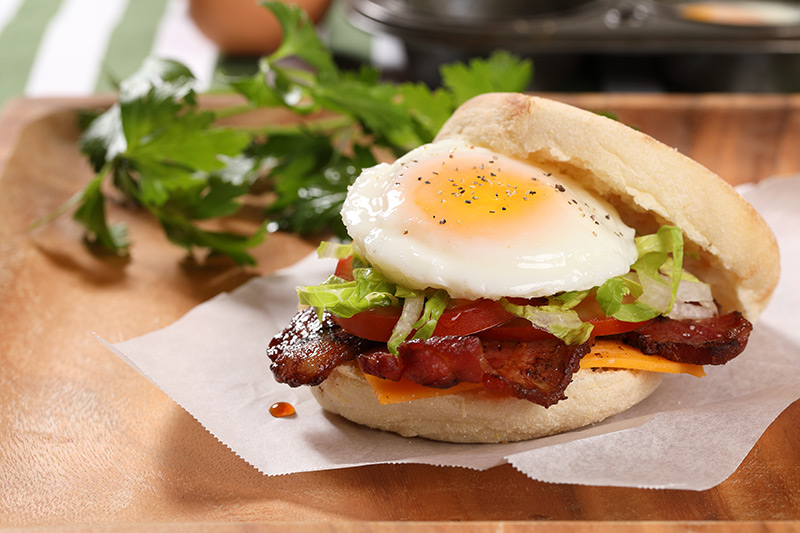
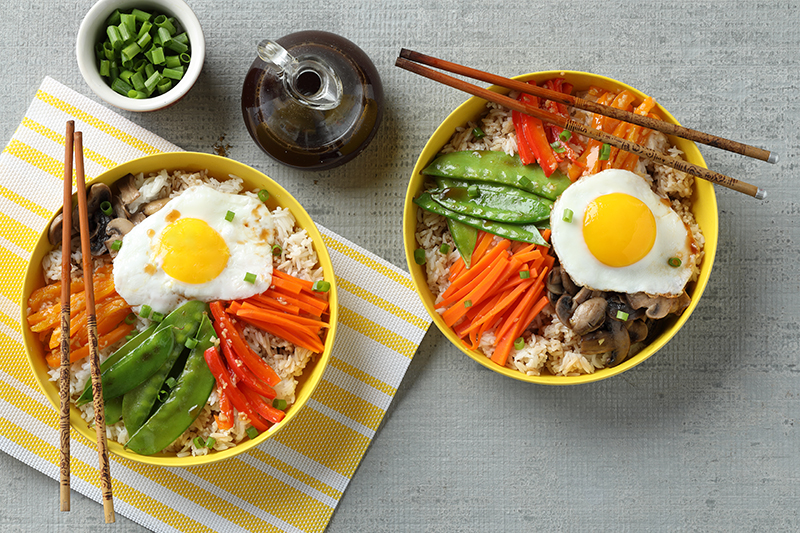 Affordable Meals
Affordable Meals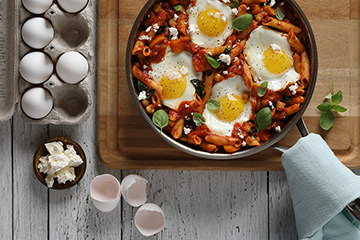 New Recipes
New Recipes Powered by Eggs
Powered by Eggs Ho Ho Holidays!
Ho Ho Holidays! Recipe Booklets
Recipe Booklets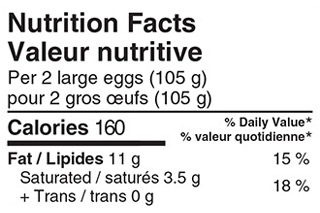 Egg Nutrition
Egg Nutrition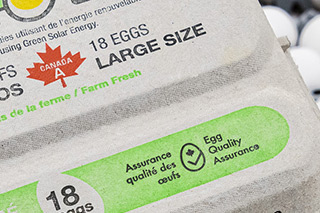 Care & Quality
Care & Quality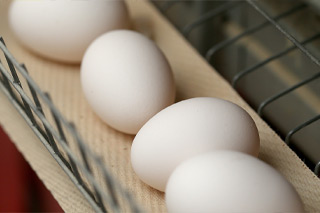 Types of Eggs
Types of Eggs